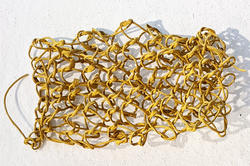Students in a cross-disciplinary fall studio interpret cultural history and use geo-textiles to restore what was once described as “America’s hardest-working river.”
Restoring the Blackstone River

With the help of a generous grant from the National Endowment for the Arts and the Narragansett Bay Estuary Program, Associate Professor of Landscape Architecture Emily Vogler and RISD alum and Northeastern University Assistant Professor José R. Menéndez MFA 17 GD are tackling issues affecting the Blackstone River such as aging dam infrastructures, pollution and inequitable river access through their project Blackstone River Commons. They aim to bring communities together to restore the 48-mile river, which runs from Worcester, MA to Pawtucket Falls in Rhode Island by hosting pop-up events, leading paddles down the river and more.

Once referred to as “America’s hardest working river,” the Blackstone suffered from toxic dumping throughout the 19th century and at its peak had more than 34 dams along its length to provide hydropower to textiles factories. Through events such as a recent 60-mile paddle down the Blackstone and Seekonk rivers, Vogler and Menéndez are drawing attention to the river’s history while strengthening bonds throughout the community.

“As artists and designers,” says Vogler, “we have the ability to reframe scientific information in a way that allows more people to engage in these topics and become stewards of the Blackstone.”
“Every river has a story, and there is so much that we can learn from the ways in which different cultures relate to and interact with the environment.”
In spearheading this project, the two designers have placed an emphasis on connectivity. “What I love about rivers is that there are so many histories,” says Vogler. “Every river has a story, and there is so much that we can learn from the ways in which different cultures relate to and interact with the environment over time.”

Working closely with Stefanie Covino from the Blackstone Watershed Collaborative, they have developed outreach materials such as postcards, bookmarks and posters that they’re handing out to local residents. “We wanted to start with very simple and approachable methods of communication,” says Menéndez. “You can hold postcards in your hands.” The red, white and blue graphics include imagery of people rowing, biking and walking along the river, as well as local wildlife to emphasize a sense of unity and shared responsibility for the environment.

At a pop-up event at Narragansett Brewery in Providence, Menéndez and his colleagues at Counterform Studio, including Tatiana Gómez MFA 18 GD, set up a stack of unfinished posters and a letterpress, and guests had the opportunity to contribute to the making process by printing the name Kittacuck onto the posters. “We introduced the river’s original name given by Indigenous peoples as a methodology to amplify its cultural history,” says Menéndez. “People were able to find joy in doing something tangible to contribute to the process, and it spurred meaningful conversation.”
“People were able to find joy in doing something tangible to contribute to the process, and it spurred meaningful conversation.”
Though information is most frequently spread on social media these days, the artist finds tangible materials to be more impactful. “People told me that they were going to go home and put the posters on their fridges,” he says. “The kitchen is the center of the home, and that’s where conversation starts. I would rather be on everybody’s fridges than on their Instagrams.”

A recent four-day community event began with remarks on climate change and nature-based solutions from speakers such as Massachusetts State Representative Daniel Donahue, Worcester Department of Public Works Commissioner Jay Fink, Nipmuc tribal knowledge keeper Bruce Curlis and Save the Bay Advocacy Director Topher Hamblett. Afterwards, the group embarked on the first leg of a multi-day paddle. Pop-up events and activities in the following days included a family-friendly RiverFest with food trucks, live music and community games, learning from 18 wastewater treatment plant operators and a panel discussion about aging dams and fish passage.

Looking to the future, Vogler and Menéndez are working on an anthology that will include archival materials, essays and interviews about the project. They are soliciting letters from local community members with the following prompt: “If you could have a conversation with the Blackstone River, what would you say?”

Vogler hopes the Blackstone River Commons project helps identify and advance physical projects that improve the river’s health and resilience as well as equitable access to its waters. This work can build on her previous fall studio GeoTextiles: Weaving Restoration Ecology and Cultural Narratives along the Blackstone River, in which students used willow weaving to reduce erosion along the river. “Months later the erosion control test strip we made is still surviving and thriving,” says Vogler. “People genuinely want to help and participate in stewardship and care of the places they love, and art and design practices can provide meaningful ways for community members to connect with each other and the places they call home.”
—Isabel Roberts
August 30, 2022


